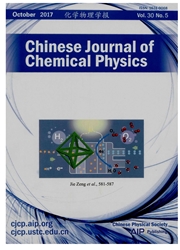

 中文摘要:
中文摘要:
成功研制了新一代纳米氦液滴实验装置.氦液滴是由高压的高纯氦气通过超低温的脉冲阀绝热膨胀形成的,通过调节连接在超低温氦冷头上的脉冲阀的温度(10-30K)及脉冲阀内氦气的背景压力(10-40atm),氦液滴的大小在包含10^3到10^5个氦原子间连续可调,和传统的连续氦液滴束源比较起来,脉冲束源的强度提高了一个量级以上,提供了一个和商品化脉冲激光器结合使用,研究超低温条件下超流体氦中的化学反应动力学的机会.通过研究氦液滴中包裹的CH31分子的光解动力学来对仪器的性能进行测试,利用离子速度影像技术研究了超低温纳米氦液滴中包裹的CH31分子在252nm下的光解动力学,光解产物甲基通过(2+1)共振增强多光子电离并运用离子影像进行检测,结果表明光解产物的平动能及角分布被氦原子环境有效的弛豫.也证实了运用脉冲氦液滴束源研究衰减光谱的可行性,通过对氦液滴中掺杂苯的衰减光谱的研究,还发现小于3%的衰减信号都可以被检测到,表明所研制的脉冲氦液滴束的稳定性及检测器的灵敏序都是很高的。
 英文摘要:
英文摘要:
A new pulsed helium nano droplets machine has been constructed. The droplets were gener- ated by expansion of the pure helium through the cryogenic valve attached to a closed-cycle cryostat. The mean size of helium droplets can be controlled between 103 and 105 helium atoms by tuning the backing pressure (10-40 bar) and temperature (10-30 K). Compared with the continuous-flow beam source, the density of droplet is at least one order of magni- tude higher, which offers the opportunity to combine the system with the commercial pulsed laser to study chemical reactions inside of the superfluid helium at ultra-low temperature. The performance for the system has been checked by studying the photodissociation of CH3I doped droplets at 252 nm with the velocity map imaging technique. The photofragments, CH3, were detected by (2+1) resonance enhanced multiphoton ionization. The speed and angular distributions derived from resulting images show clear evidence of the relaxation effect by the surrounding helium atoms. The pulsed helium droplets depletion spectroscopy was also demonstrated. The depletion spectrum of benzene doped helium droplets indicates that less than 3% depletion can be observed with the newly constructed apparatus.
 同期刊论文项目
同期刊论文项目
 同项目期刊论文
同项目期刊论文
 期刊信息
期刊信息
